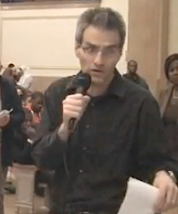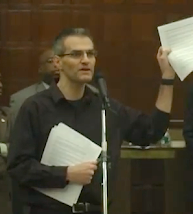IV. Learning conditions“Students’ learning conditions are teachers’ working conditions”
Well-run schools with well-trained staffs, good programs, supportive services and small classes can bring about improvements for all children. To think that communities with vast economic and social differences can succeed with identical monetary resources is a mistaken notion and a popular political ploy. Union officials must be ready to expose such lies and not allow failures in our society to fall squarely on the backs of educators.
They must be willing to put their muscle behind the struggle to:
Lower class size.
Small classes are the underpinning of an effective classroom, and are especially crucial where children have low performance levels and special needs. Union managers went along with the Board of Ed in the mid-1970s when it shut down schools and gave the buildings away, paving the way for the current overcrowding. They continue to undermine the fight for lower class sizes by: not successfully tying class size to learning conditions; preferring a referendum on lowering class size to contractual stipulation, which would be subject to grievable limits; supporting out-of-classroom positions (mentors, staff developers, coaches, etc.) that only divert money for pedagogical personnel away from the classroom; supporting and/or tolerating mandated programs and methodologies (e.g., multiple grouping, balanced literacy) that are impossible to implement in classes of more than 19-20 students; and allowing registers of 50 students in music and phys ed in some levels.
It is the UFT contract, and only the UFT contract that places any limits on class size. Without the class size caps in the contract, Bloomberg and Klein would put 50 students in each class. After all, they never tire of saying that class size is irrelevant and that only “teacher quality” matters.
Our union’s position on class size should be:— Class size limits must be comparable with other districts in the state and capped by contract. They should be reduced to the levels called for in the CFE decision: 20 for grades K-3 and 23 for grades 4-12.
— No half-class size loopholes, and no excuses in overcrowded buildings.
— Identical caps on all academic subjects within a specific level (ES, MS, HS).
End mandated programs and school organization.
Mandated teaching blocks have minimized or eliminated music, art, foreign language and specialized classes. UFT officials have responded weakly to the DoE’s mockery of New York State requirements and the reduction of programs meaningful to so many youngsters. When principals were given autonomy over the budget, the decision-making power of the School Leadership Teams was drastically reduced. Principals now have the final say over which programs will be retained and installed. Furthermore, whereas some aspects of mandated programs may be valid, inadequate resources, rigidity in implementation and poor training reduce their value (e.g., the NCEE literacy program in HSS, which is not practicable).
It is our belief that:— Music, art, foreign language, phys ed, health, library, technology and vocational learning are basic to education and should be restored to the curriculum.
— The union, which is bound by its own Constitution “to promote education as a social agency for developing the capacities of the young,” must demand that state requirements for advancement and graduation be honored in full. It must also demand that the state’s education goals be meaningful, relevant and long-term.
— School Leadership Teams must be empowered to establish a Comprehensive Education Plan for the school and make school-based budget decisions; an appeal process must set up to handle cases where consensus cannot be reached.
End the misuse of city- and statewide tests,
Such tests increasingly distort the curricula and misrepresent true academic performance. Standardized test results can be a tool for evaluating instruction and pointing out where extra resources should be focused, but the current accountability model with its simplified goals and objectives results in a numbers game for students and teachers. This model also ignores any accountability for long-term learning goals or the kinds of learning that might give educators and students cause for satisfaction.
Good teachers develop an awareness of how children actually learn. The premise that children will learn more when they are subjected to weeks of teaching-to-the-test methodologies, that they become more successful students when strict standardized levels are set for them, or that they respond positively to threats and punishment are ideologically driven beliefs and contrary to what we know as experienced educators. A consequence of high stakes testing is that children most in need become a liability to a school, and passing them off to another school becomes a more attractive option than addressing their needs.
In an effort to support the mayor’s political agenda, the chancellor has invalidated the use of such testing by changing the student populations that take them, adjusting the time of year that tests are taken, and manipulating the data culled from the results.
Certain kinds of tests (such as ECLAS) administered to every child in the early grades is not only a waste of time and resources, but disrupts learning for many days each year and rarely gives teachers any new information about their student.
It is our position that:— Teachers, not tests, must play a primary role in student evaluation procedures at all levels.
— Students should have the opportunity to demonstrate their learning in a variety of ways.
— Teaching to the test, dumbing down, and selective data analysis are all derived from political decisions and are detrimental to children’s learning.
— ECLAS testing is harmful to learning environments, and it should not be administered to all children in the early grades.
— No schools should be closed based on standardized tests or school report cards. The DoE must show that closing a school is a measure of last resort. Before a school can be closed, the DoE must provide extra to fix its problems and communicates with the staff and the community.
Adequately address the needs of troubled students.
Formulating a strategy to deal with such students involves the collaboration of teachers, other school staff, and parents. Children who come to school too troubled to maintain themselves in a general ed class need sustained and professional interventions. Not only are there fewer self-contained in the restructured system, but the lack of adequate training, vast discrepancies in the quality of programs, insufficient staff, faulty evaluations leading to inappropriate placements, and the resistance of many parents to having their children labeled are some of the factors that have weakened the special ed structures in our schools. With the dismantling of services for all but the most challenged students and the inability to accommodate many others who might fall into this category but have not been classified special ed as yet, we see thousands of teachers throughout the city having to deal with students who challenge the classroom environment on a regular basis and threaten the safety and well-being of other students and staff, as well harming themselves.
The “disciplinary responses” listed in the DoE’s Citywide Standards of Discipline and Intervention Measures (September 2008), which allow for special rooms to hold students who are disrupting a class for a period of 1-4 days, cannot for the most part be used by classroom teachers. There is simply too much behavior that is “substantially disruptive” or that “substantially interferes with a teacher’s authority over the classroom” to be handled by simple removal. In practice, underlying problems cannot easily be resolved, students do not get adequate instruction when they are placed in such rooms, and a removal is rarely a deterrent.
Administrators seem to have abandoned the notion of modeling respectful behavior towards peers and admonish teachers in the presence of students.
ICE recognizes that although most student situations are handled by classroom teachers and in some cases paras, there are school workers in other unions who attend to the learning environment in different capacities. These include the custodial staff, cafeteria workers, security guards, engineers, and police.
ICE believes that:— Strategies for dealing with students who disrupt the classroom must include ongoing consensus-building among adults and taking actions based on this consensus. Early intervention, guidance, conflict management, and mutual respect are essential for protecting learning environments from patterns of disruption.
— The DoE must provide alternative settings for those students who do not respond to the efforts of school staff and parents to improve their behavior.
— The union must convince administrators who do not behave professionally towards members, particularly in front of students, that their behavior is not only unacceptable and reportable (to OSI), but of no benefit to children who are in the process of acquiring role models.
— All public school workers contribute to the proper running of the school and their well-being is important to our union.
Expand existing adult education programs in content and number of courses available.
Adult education must take into account the needs of parents and community members and should include their understandings and views of what will help serve their community. It can be a vehicle to strengthen the bonds between parents, educators and unionists that will help us in our united effort to get better schools for the city’s children. ICE believes that the DoE should renew its commitment to adult education.
Monday, October 12, 2009
ICE platform, Part IV
Subscribe to:
Post Comments (Atom)













No comments:
Post a Comment